Your life is not about what people expect you to be. It's about following your heart to be what you want to be.
Sunday, July 31, 2011
Thursday, July 28, 2011
Over the San Juan Mountains
Wednesday, May 11th - - After a little stop in Alamosa, about 25 miles southwest of the Great Sand Dunes, I continued west on U.S. 160/285.

I was somewhat alarmed at what I saw down the road after leaving Alamosa. I did get into some rain and, at the higher elevations, some snow. But it wasn't really all that bad. The temperature was 49 degrees with a fairly strong wind. By the time I got to the summit at Wolf Creek Pass, (elevation 10,685 feet) the temperature had dropped to 25 degrees. It warmed back up once over the mountains.

On the way up to the summit at Wolf Creek Pass.

On the other side of the San Juan Mountains.

Love this! A nice shot purely by chance! It helps when you roll down the window and the sun comes out for a second.

I was somewhat alarmed at what I saw down the road after leaving Alamosa. I did get into some rain and, at the higher elevations, some snow. But it wasn't really all that bad. The temperature was 49 degrees with a fairly strong wind. By the time I got to the summit at Wolf Creek Pass, (elevation 10,685 feet) the temperature had dropped to 25 degrees. It warmed back up once over the mountains.

On the way up to the summit at Wolf Creek Pass.

On the other side of the San Juan Mountains.

Love this! A nice shot purely by chance! It helps when you roll down the window and the sun comes out for a second.
A Most Excellent Adventure :: Humpback Whales!
Friday, August 27th - - On my way to Juneau on the Alaska Ferry on Wednesday several people offered their opinions on the best tours there. The overwhelming consensus was that the Tracy Arm Cruise to the Sawyer Glaciers with the Adventure Bound was the absolute best. So the first thing I did when I got to Juneau was to stop by their office, which was very easy to find, and make my reservation.
 Our cruise was aboard the little boat on the left, which is owned by Steve and Winona Weber. Steve is also the Captain of the boat and he promised us it was going to be a great day – especially since it was his birthday!
Our cruise was aboard the little boat on the left, which is owned by Steve and Winona Weber. Steve is also the Captain of the boat and he promised us it was going to be a great day – especially since it was his birthday!
Departure was right on time at eight o'clock. Not quite filled to capacity there were about 40 passengers onboard. As you can see, it was another cloudy-gray day and we all had our fingers crossed just hoping that it would not rain.
Because of the overcast skies, the first portion of the cruise was a little dreary. The clouds generally covered the mountain tops, or rather they hovered over them and everything was rather grayish and dull looking. Some of us would occasionally go outside for a little while but when the boat was moving at full speed it was very cold.
Not quite an hour into the cruise, Captain Steve made a sharp turn to starboard (right) and broadcast over the loudspeaker that whales had been sighted. He went on to say that he usually doesn't stop for whale sightings on the way to the glaciers but that these were too good to pass by.
Everyone was excited. We couldn't see them in front of us yet but could tell that the Captain was excited too. After what seemed like a long time, but in actuality was only about 15 minutes, the boat slowed down. Still in the distance up ahead we could see three whales spouting off. Wondering why he didn't go closer, we were directed to look to the right and there was a pod of seven Humpback whales – and they weren't very far away! We had all been so intent on looking at what was ahead of us that no one had seen the second group of whales.
They were amazing. After about ten minutes they disappeared beneath the surface of the water. When they resurfaced, Steve moved closer towards them. The first group of three that we had seen had moved south while these seven were going north. Then we saw another group of three coming towards us. Several times the whales went beneath the surface and each time Steve went after them. At one time the whales were quite close to the boat. It was so much fun watching them. It was incredible. None of the whales breached – jumped up out of the water – but they were so cool to watch. Everyone was on the outside decks, moving around, trying to get the best shot. You could feel the excitement.
 Three in a row.
Three in a row.
 Going down.
Going down.
 They were so close together! One spouting and another going down.
They were so close together! One spouting and another going down.
 They were coming right towards us! But they turned before they got closer.
They were coming right towards us! But they turned before they got closer.
 Three of them together.
Three of them together.
 A few more tail flips...
A few more tail flips...

 Then there were at least four of them together!
Then there were at least four of them together!
 Huge and amazing!
Huge and amazing!
 And then they were gone... Awesome!
And then they were gone... Awesome!
We spent about half an hour with the whales and when they came up the last time they were way, way off in the distance. Steve turned the boat around and we resumed our journey to the glaciers. It was one of those “WOW” moments (many times over). Talking with several other passengers, one of them made the comment that nothing could top that! But he was to be proven wrong...
 Our cruise was aboard the little boat on the left, which is owned by Steve and Winona Weber. Steve is also the Captain of the boat and he promised us it was going to be a great day – especially since it was his birthday!
Our cruise was aboard the little boat on the left, which is owned by Steve and Winona Weber. Steve is also the Captain of the boat and he promised us it was going to be a great day – especially since it was his birthday!Departure was right on time at eight o'clock. Not quite filled to capacity there were about 40 passengers onboard. As you can see, it was another cloudy-gray day and we all had our fingers crossed just hoping that it would not rain.
Because of the overcast skies, the first portion of the cruise was a little dreary. The clouds generally covered the mountain tops, or rather they hovered over them and everything was rather grayish and dull looking. Some of us would occasionally go outside for a little while but when the boat was moving at full speed it was very cold.
Not quite an hour into the cruise, Captain Steve made a sharp turn to starboard (right) and broadcast over the loudspeaker that whales had been sighted. He went on to say that he usually doesn't stop for whale sightings on the way to the glaciers but that these were too good to pass by.
Everyone was excited. We couldn't see them in front of us yet but could tell that the Captain was excited too. After what seemed like a long time, but in actuality was only about 15 minutes, the boat slowed down. Still in the distance up ahead we could see three whales spouting off. Wondering why he didn't go closer, we were directed to look to the right and there was a pod of seven Humpback whales – and they weren't very far away! We had all been so intent on looking at what was ahead of us that no one had seen the second group of whales.
They were amazing. After about ten minutes they disappeared beneath the surface of the water. When they resurfaced, Steve moved closer towards them. The first group of three that we had seen had moved south while these seven were going north. Then we saw another group of three coming towards us. Several times the whales went beneath the surface and each time Steve went after them. At one time the whales were quite close to the boat. It was so much fun watching them. It was incredible. None of the whales breached – jumped up out of the water – but they were so cool to watch. Everyone was on the outside decks, moving around, trying to get the best shot. You could feel the excitement.
 Three in a row.
Three in a row. Going down.
Going down. They were so close together! One spouting and another going down.
They were so close together! One spouting and another going down. They were coming right towards us! But they turned before they got closer.
They were coming right towards us! But they turned before they got closer. Three of them together.
Three of them together.  A few more tail flips...
A few more tail flips...
 Then there were at least four of them together!
Then there were at least four of them together! Huge and amazing!
Huge and amazing! And then they were gone... Awesome!
And then they were gone... Awesome!We spent about half an hour with the whales and when they came up the last time they were way, way off in the distance. Steve turned the boat around and we resumed our journey to the glaciers. It was one of those “WOW” moments (many times over). Talking with several other passengers, one of them made the comment that nothing could top that! But he was to be proven wrong...
Wednesday, July 27, 2011
Yellowstone :: Mammoth Hot Spring Terraces
Friday, September 2nd - - The temperature was even cooler this morning – a rather brisk 29 degrees! There was some frost on the rear window. I drove down to Yellowstone Lake and found a drive that went along the shoreline for a little ways.

The sun had already risen above the mountain tops and there was a lot of haze in the sky. It was the perfect place for breakfast on this, my last morning in the park!
I decided to revisit the Mammoth Hot Springs Terrace, specifically the Upper Terrace where there was actually a road that wound its way through the area. Driving the “long way” around, going south then west then north, it took me nearly 3 hours to reach the Terraces. Of course, I did stop a few times along the way...
And, wow, what a difference a day makes! With a good nights rest and better lighting conditions, the terraces looked completely different than they did the previous day.

Prospect Spring, which flows into the Highland Terrace, and those microscopic thermophiles that make it so colorful.

Leaves and twigs fall into the shallow waters and are transformed by the minerals in the water.

Thermophiles (those heat-loving microorganisms) create tapestries of color where hot water flows among the terraces. Colorless and yellow thermophiles grow in the hottest water; orange, brown, and green thermophiles thrive in cooler waters. The colors also change with the seasons.

The terraces are formed by a combination of factors: The hot water beneath the surface dissolves carbon dioxide that makes a solution of weak carbonic acid. As the solution rises through rock, it dissolves calcium carbonate, the primary compound in limestone. At the surface, the calcium carbonate is deposited in the form of travertine, the rock that forms the terraces of Mammoth Hot Springs.

There is a constant state of flux as the water moves over the surface and the terraces grow.

Over the years, the terraces grow and expand, encroaching on areas where trees had thrived.

The above photo was taken when I visited the park in July 1979. It is a lower angle and doesn't show as much of the “face” of the terraces but, with the position of the mountains in the background, I think it was taken in the same area as the next two photos.

Of course, 34 years have gone by, and some change was to be expected, but this is a lot of change! The Park Ranger stated that the boardwalk in this area has been moved back twice and will have to be moved again within a few years.

Growth and change, dependent upon the flow of water.

I was enthralled by the various colors of the pools of water in the smaller terraces.

And by what is left behind when the water no longer flows.

This visit to the Mammoth Hot Spring Terraces was the perfect ending to my short stay at Yellowstone National Park!

The sun had already risen above the mountain tops and there was a lot of haze in the sky. It was the perfect place for breakfast on this, my last morning in the park!
I decided to revisit the Mammoth Hot Springs Terrace, specifically the Upper Terrace where there was actually a road that wound its way through the area. Driving the “long way” around, going south then west then north, it took me nearly 3 hours to reach the Terraces. Of course, I did stop a few times along the way...
And, wow, what a difference a day makes! With a good nights rest and better lighting conditions, the terraces looked completely different than they did the previous day.

Prospect Spring, which flows into the Highland Terrace, and those microscopic thermophiles that make it so colorful.

Leaves and twigs fall into the shallow waters and are transformed by the minerals in the water.

Thermophiles (those heat-loving microorganisms) create tapestries of color where hot water flows among the terraces. Colorless and yellow thermophiles grow in the hottest water; orange, brown, and green thermophiles thrive in cooler waters. The colors also change with the seasons.

The terraces are formed by a combination of factors: The hot water beneath the surface dissolves carbon dioxide that makes a solution of weak carbonic acid. As the solution rises through rock, it dissolves calcium carbonate, the primary compound in limestone. At the surface, the calcium carbonate is deposited in the form of travertine, the rock that forms the terraces of Mammoth Hot Springs.

There is a constant state of flux as the water moves over the surface and the terraces grow.

Over the years, the terraces grow and expand, encroaching on areas where trees had thrived.

The above photo was taken when I visited the park in July 1979. It is a lower angle and doesn't show as much of the “face” of the terraces but, with the position of the mountains in the background, I think it was taken in the same area as the next two photos.

Of course, 34 years have gone by, and some change was to be expected, but this is a lot of change! The Park Ranger stated that the boardwalk in this area has been moved back twice and will have to be moved again within a few years.

Growth and change, dependent upon the flow of water.

I was enthralled by the various colors of the pools of water in the smaller terraces.

And by what is left behind when the water no longer flows.

This visit to the Mammoth Hot Spring Terraces was the perfect ending to my short stay at Yellowstone National Park!
Tuesday, July 26, 2011
The Round House
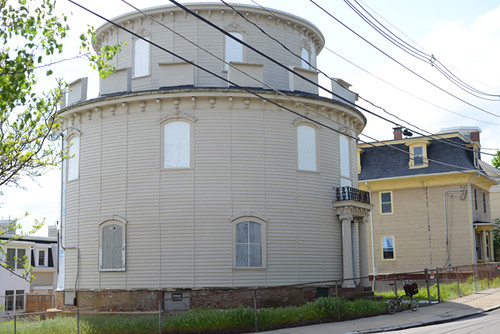
It is no small task to describe the entity that is "Camberville" - that serpentine Somerville-Cambridge city line with its mazes of pocket neighbourhoods, unkempt grapevines, mysterious alleys lined with crumpling garages, and grandiose structures tucked away on sleepy side streets. Wandering through a neighbourhood you think you know, it is not unusual to encounter something wholly unexpected - perhaps a sidewalk treehouse, an enchanted forest, a small castle, or a warehouse-sized artisan incubator.

Very possibly I have cycled past the Round House before without taking much notice. The once-grand structure is not difficult to miss, now only a shadow of its former self. A lusciously overgrown garden torn out some years ago, a grass lot and chainlink fence now surround its bare walls, stripped of trim and embellishment. A thicket of condominiums stands in what was once an open space, blocking the house from view in certain directions.
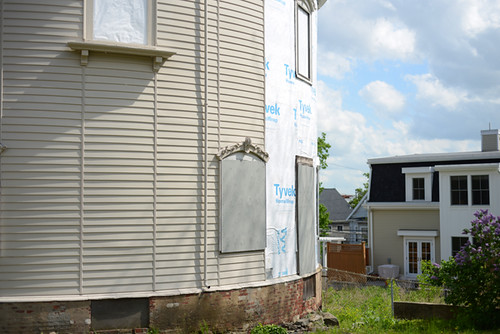
But on this ghostly-quiet afternoon, I noticed it straight away. It was one of those humid days when the air stands still and the scent of flowers is sickly sweet. The weekend's explosion of lilacs was making me lightheaded. I cycled up a steep hill, and as I turned the corner onto a tiny one-way street the house appeared like a hallucination -backlit by the waning sun and tilting slightly to the left.
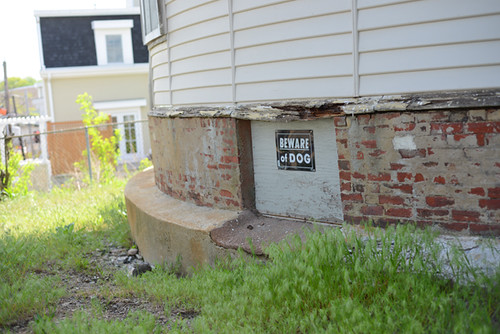
Stopping to have a look, I was distracted by the prominent signs discouraging trespassing. They struck me as so insincere as to almost be playful.

I was intrigued further by the curious discrepancy between the siding - which appeared newly installed - and the foundation, which seemed on the verge of collapse.
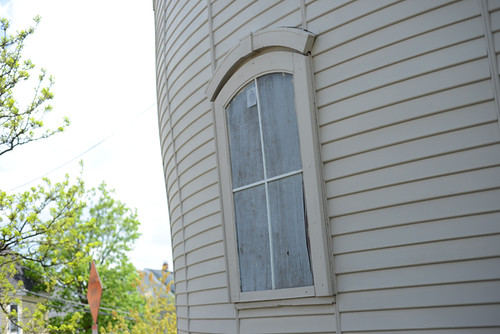
And then there was the bulging wall.
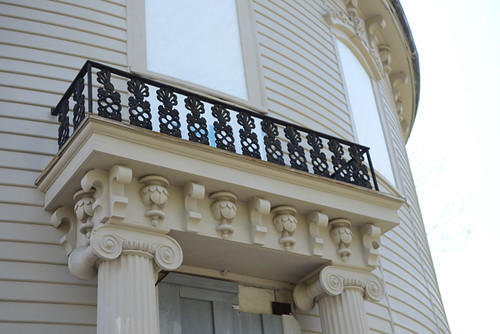
Strange to think that a Victorian-era locksmith is responsible for this cylindrical wonder. Inspired by the idea of octagonal houses floating around at the time, Somerville resident Enoch Robinson decided to take things one step further and build a round house. Constructed in 1856, the 3-story single family residence housed generations of Robinson's family.

It is not clear why the Round House was vacated and stood empty for so long. But by the 1980s it had its windowsand ornamentation removed, had suffered water damage and faced serious structural problems. There was talk of tearing it down, which, predictably, riled up residents who saw it as a landmark of historical value. Thankfully, it never came to that. Several years ago, the house was purchased by a developer with experience in historical preservation. He plans to restore the house and place it on the market as a single family home.

The Round House was created on a whim, to satisfy a personal interest - possibly an obsession, judging by the limited information I found on its creator. Yet by virtue of existing in a publicly visible and visitable space, it is also a communal resource, and will continue to be as ownership changes hands. How will the new residents feel about that, I wondered, eying the awkward battlements that surround the top story. I hope they plant a nice garden. Maybe some lilacs, dogwood and pines, against that stark beige facade.
Monday, July 25, 2011
Mt. Rainier, DC

Starting the climb in fresh snow.

Taking a break.

Mt. Adams and the Tatoosh Range.

Tent city on the Cowlitz Glacier at Camp Muir.

Camp Muir above a sea of clouds with Mount Adams in background.

Sunrise with Little Tahoma on the right.
 Mount Stuart Range on the left.
Mount Stuart Range on the left.
Ascending Disappointment Cleaver.

The Ingraham Ice Fall.

Bethany's high point. The top of Disappointment Cleaver at 12,300'! Gibraltar Rock and Mt. Adams in the background.

Four of the finest on top of Rainier!(Jim, Mark, Theresa and Dave)
 Descending Disappointment Cleaver. The tiny dots, at the top center, are tents at Ingraham Flats.
Descending Disappointment Cleaver. The tiny dots, at the top center, are tents at Ingraham Flats.
Subscribe to:
Posts (Atom)







